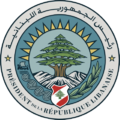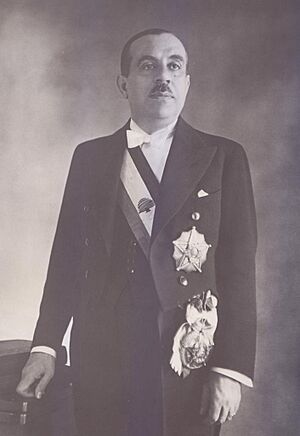President of Lebanon facts for kids
Quick facts for kids President of theLebanese Republic |
|
|---|---|

Presidential Seal
|
|
| Style | His Excellency |
| Residence | Baabda Palace Beiteddine Palace (summer) |
| Appointer | Parliament |
| Term length | Six years,
non-renewable immediately but renewable non-consecutively
|
| Constituting instrument | Constitution of Lebanon (1926) |
| Formation | 1 September 1926 |
| First holder | Charles Debbas |
| Salary | £L225,000,000 annually |
The President of the Lebanese Republic is the head of state for Lebanon. This means the president is the top leader and symbol of the country. The president is chosen by the parliament for a six-year term. They cannot be re-elected right away.
By an old agreement called the National Pact, the president is always a Maronite Christian. They must meet the same requirements as other members of parliament.
Joseph Aoun became the current president on January 9, 2025.
Contents
A Look Back: The President's Journey
Early Days: French Rule
Lebanon's first constitution was created on May 23, 1926. It was similar to France's government at the time. It set up a parliament, a president, and a group of ministers (the cabinet).
The president was elected by the parliament for one six-year term. They could not be re-elected for another six years after their term ended. Members of parliament were chosen based on their religious groups.
During this time, it became a custom to choose top political leaders based on their religious group's size in the population. For example, the president was usually a Maronite Christian. The prime minister was a Sunni Muslim. The speaker of parliament was a Shia Muslim. A Greek Orthodox and a Druze person were always in the cabinet. This system gave a lot of power to the Maronite president. It also made it harder for Lebanese people to feel like one nation.
Even with the constitution, the French high commissioner still had the most power. Charles Debbas, a Greek Orthodox Christian, became Lebanon's first president in 1926.
In 1932, when Debbas's term ended, two candidates, Bishara al-Khuri and Émile Eddé, wanted to be president. This caused a problem in parliament. To solve it, some suggested Muhammad al-Jisr, a Muslim leader. However, the French high commissioner stopped the constitution and extended Debbas's term. This prevented a Muslim from becoming president.
Later, another French official appointed Habib Pacha Es-Saad as president for a short time. Émile Eddé was elected president in 1936. But the constitution was stopped again in 1939 when World War II began.
During World War II, French officials allowed Nazi Germany to move supplies through Syria. Britain worried Germany would take control of Lebanon and Syria. So, Britain sent its army into the region.
After the fighting, General Charles de Gaulle visited Lebanon. He decided to recognize Lebanon's independence. On November 26, 1941, General Georges Catroux announced Lebanon would be independent.
Elections were held in 1943. On November 8, 1943, the new Lebanese government declared independence. The French reacted by putting the new government in prison. But under pressure from their allies, the French released them. Bechara El Khoury was restored as president on November 21. He was re-elected in 1948.
El Khoury faced challenges from powerful traditional leaders. In 1952, he was forced to resign after many protests.
After Independence
In 1952, Fouad Chehab refused to use the army to stop the protests that led to President El Khoury's resignation. Chehab became prime minister and defense minister. He was then appointed president to ensure a fair election.
Four days later, Camille Chamoun was elected president. During his time, Lebanon's economy grew, especially in building, banking, and tourism. He made laws to help businesses and banking secrecy.
In 1958, President Chamoun tried to change the constitution to be re-elected. This led to him resigning. Groups supported by Gamal Abdel Nasser tried to overthrow Chamoun's government. Clashes happened between Muslim and Christian groups. This led to the United States sending its army to Lebanon in July 1958. This was to protect the government from threats.
The president of Lebanon is elected by the Parliament of Lebanon. Before the 1958 election, parliament was divided. Chehab was seen as a good choice because he could unite different groups. He became president on July 28, 1958. He worked with various religious and political groups to bring stability back to Lebanon.
Michel Helou was elected as the fourth president in 1964. He was seen as a leader who could unite Lebanon. The Six-Day War in 1967 caused problems between religious groups in Lebanon. Many Muslims wanted Lebanon to join the Arab war effort. Many Christians wanted to stay out of it. Helou managed to keep Lebanon mostly out of the conflict.
Armed Palestinian fighters in southern Lebanon also challenged the government. Clashes between the Lebanese army and the Palestine Liberation Organization (PLO) became common. Helou tried to stop them. In 1969, he agreed to let the Palestinian fighters operate, hoping they would only attack Israel. But the clashes continued.
In 1970, Helou supported Elias Sarkis to be his successor. But Sarkis lost the election by one vote to Suleiman Frangieh.
Civil War in Lebanon
The Lebanese Civil War started on April 13, 1975. President Frangieh tried to end the conflict in 1976. He suggested giving more power to the prime minister and making Christians and Muslims equal in parliament. This plan was supported by many leaders, but it did not stop the war.
Élias Sarkis was elected president in 1976. He was hoped to unite the fighting groups. But by September 1976, the situation was out of control. Syria and other countries started getting involved. Sarkis tried to create national peace. He wanted unity, independence, and democracy.
During the civil war, an election was held in 1982. Bachir Gemayel was elected president. He was the youngest president ever chosen. He had close ties with Israel. He was assassinated in an explosion before he could officially take office. His brother, Amine Gemayel, became president after him.
On September 22, 1988, just before his term ended, President Amine Gemayel appointed Michel Aoun as prime minister. This was unusual because the prime minister is usually a Sunni Muslim. Aoun led a military government. Muslim members of this government refused to serve. This led to two rival governments. Aoun stayed in the presidential palace, while another prime minister, Selim Hoss, set up his office in West Beirut. In 1990, the civil war ended when Aoun surrendered after an attack on the palace by Syrian and Lebanese forces.
After the Civil War
After the Taif Agreement ended the civil war, the parliament met on November 5, 1989. They elected Rene Moawad as president. The position had been empty since 1988. Seventeen days later, on November 22, 1989, Moawad was killed by a car bomb in West Beirut.
Presidential powers were given to the cabinet for two days. Then, Elias Hrawi was elected president on November 24, 1989. The presidential residence, Baabda Palace, was destroyed during the war. So, Hrawi lived in future prime minister Rafik Hariri's apartment.
Emile Lahoud became president in 1998. The constitution was changed to allow an army commander to run for office. This change was believed to be supported by Syria. Lahoud won with many votes from parliament. He worked closely with Hezbollah and chose his own prime minister, Selim al-Hoss. This caused tension between Lahoud and Rafiq Hariri. Lahoud had more control over government decisions than the prime minister or parliament speaker. His term ended in 2007.
After Lahoud, a new president was not elected right away. The position was empty for six months. Then, Michel Suleiman, a former army chief, was elected president.
Today
From May 2014 until October 31, 2016, the president's office was empty for almost two and a half years. Parliament could not get enough votes to elect a new president. On October 31, 2016, Michel Aoun was elected president. He served until October 30, 2022. After his term ended, parliament again struggled to elect a successor. However, on January 9, 2025, Joseph Aoun was finally sworn in as President.
The President's Job
Who Can Be President?
The constitution says the president must have the same qualifications as a member of Parliament. This means they must be a Lebanese citizen and at least 21 years old.
Even though it's not written in the constitution, there's an agreement from 1943 called the National Pact. This agreement says the president must be a Maronite Christian. This was a deal made when Lebanon became independent from France. It also says the prime minister should be a Sunni Muslim. And the speaker of Parliament should be a Shia Muslim.
When a president takes office, they must take an oath. Article 50 of the constitution of Lebanon describes this oath:
I swear by Almighty God to observe the Constitution and the laws of the Lebanese Nation and to maintain the independence of Lebanon and its territorial integrity.
What the President Does
Lebanon is a parliamentary republic. This means the president's role is mostly symbolic. But the president is still an important part of the government. They share many powers with the Council of Ministers (the cabinet).
According to the constitution, the president:
- Is the commander-in-chief of the Lebanese Armed Forces. However, the army is under the cabinet's authority, so this role is mostly symbolic.
- Signs laws passed by Parliament.
- Negotiates and approves international treaties with the prime minister and cabinet. Some treaties also need parliament's approval.
- Appoints the prime minister after talking with the Speaker of Parliament and Parliament. The prime minister then forms a government.
- Formally appoints the prime minister once parliament approves the new government.
- Can ask the cabinet to dissolve Parliament (end its session early).
- Can ask Parliament to look at laws again.
- Can issue "emergency" laws with the cabinet's agreement.
- Can fire a minister if two-thirds of the cabinet agrees and the prime minister signs off.
The president's powers were reduced in 1990 under the Ta'if Agreement. The cabinet's powers were increased. Before, the president only needed "favorable advice" from ministers.
The president's main home is the Baabda Palace, located southeast of Beirut. Charles Helou was the first president to live there after it was built in the 1960s. The Beiteddine Palace was named the official summer residence in 1943.
How a President is Elected
Thirty to sixty days before a president's term ends, the speaker of parliament calls a special meeting. A new president is chosen by secret ballot for a six-year term. To win, a candidate needs two-thirds of the votes in the first round. If no one gets that many votes, a second vote is held. In the second vote, only a simple majority (more than half) is needed to win. A person cannot be re-elected president until six years have passed since their first term ended.
What if the Presidency is Empty?
Sometimes, the presidency in Lebanon becomes empty. This has happened three times in a row. No Lebanese president has directly handed power to a successor without a gap since Elias Hrawi was followed by Emile Lahoud in 1998.
The Lebanese constitution does not mention an "interim" or "acting" president. Instead, it says the presidency remains empty. Some of the president's powers are then given to the Council of Ministers (the cabinet). Article 62 of the constitution states: "Should there be a vacancy in the Presidency for any reason whatsoever, the Council of Ministers shall exercise the authorities of the President by delegation." When Michel Aoun left the presidency in 2022, the prime minister said that the powers would be given to the cabinet as a whole.
See also
- List of presidents of Lebanon
- Prime Minister of Lebanon
- Legislative Speaker of Lebanon





